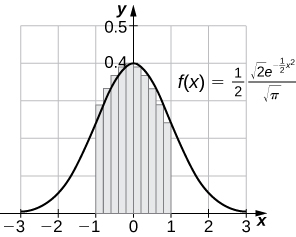5.10: 5.5E and 5.6E U-Substitution Exercises
- Last updated
- Jan 17, 2020
- Save as PDF
- Page ID
- 32822
( \newcommand{\kernel}{\mathrm{null}\,}\)
5.5: Substitution
In the following exercises, find the antiderivative.
261) ∫(x+1)4dx
- Answer:
- 15(x+1)5+C
262) ∫(x−1)5dx
263) ∫(2x−3)−7dx
- Answer:
- −112(3−2x)6+C
264) ∫(3x−2)−11dx
265) ∫x√x2+1dx
- Answer:
- √x2+1+C
266) ∫x√1−x2dx
267) ∫(x−1)(x2−2x)3dx
- Answer:
- 18(x2−2x)4+C
268) ∫(x2−2x)(x3−3x2)2dx
269) ∫cos3θdθ(Hint:cos2θ=1−sin2θ)
- Answer:
- \displaystylesinθ−sin3θ3+C
270) ∫sin3θdθ(Hint:sin2θ=1−cos2θ)
271) ∫x(1−x)99dx
Solution: (1−x)101101−(1−x)100100+C
272) ∫t(1−t2)10dt
273) ∫(11x−7)−3dx
- Answer:
- −122(7−11x2)+C
274) ∫(7x−11)4dx
275) ∫cos3θsinθdθ
- Answer:
- −cos4θ4+C
- 276) ∫sin3θdθ;u=cosθ(Hint:sin2θ=1−cos2θ)
(removed exercises 277- 280)
281) ∫x2(x3−3)2dx
- Answer:
- −13(x3−3)+C
In the following exercises, evaluate the definite integral.
292) ∫10x√1−x2dx
293) ∫10x√1+x2dx
- Answer:
- u=1+x2,du=2xdx,12∫21u−1/2du=√2−1
294) ∫20t√5+t2dt
295) ∫10t√1+t3dt
- Answer:
- u=1+t3,du=3t2,13∫21u−1/2du=23(√2−1)
296) ∫π/40sec2θtanθdθ
297) ∫π/40sinθcos4θdθ
- Answer:
- u=cosθ,du=−sinθdθ,∫11/√2u−4du=13(2√2−1)
J5.5.1)
J5.5.2)
5.6: Integrals Involving Exponential and Logarithmic Functions
In the following exercises, compute each indefinite integral.
320) ∫e2xdx
321) ∫e−3xdx
- Answer:
- −13e−3x+C
322) ∫2xdx
323) ∫3−xdx
- Answer:
- −3−xln3+C
324) ∫12xdx
325) ∫2xdx
- Answer:
- ln(x2)+C or 2ln|x|+C
326) ∫1x2dx
327) ∫1√xdx
- Answer:
- 2√x+C
In the following exercises, find each indefinite integral by using appropriate substitutions.
328) ∫lnxxdx
329) ∫dxx(lnx)2
- Answer:
- −1lnx+C
336) ∫xe−x2dx
337) ∫x2e−x3dx
- Answer:
- −e−x33+C
338) ∫esinxcosxdx
339) ∫etanxsec2xdx
- Answer:
- etanx+C
340) ∫elnxdxx
341) ∫eln(1−t)1−tdt
- Answer:
- t+C
In the following exercises, evaluate the definite integral.
355) ∫211+2x+x23x+3x2+x3dx
- Answer:
- 13ln(267)
356) ∫π/40tanxdx
357) ∫π/30sinx−cosxsinx+cosxdx
- Answer:
- ln(√3−1)
358) ∫π/2π/6cscxdx
359) ∫π/3π/4cotxdx
- Answer:
- 12ln32
In the following exercises, integrate using the indicated substitution.
360) ∫xx−100dx;u=x−100
361) ∫y−1y+1dy;u=y+1
- Answer:
- y−2ln|y+1|+C
362) ∫1−x23x−x3dx;u=3x−x3
363) ∫sinx+cosxsinx−cosxdx;u=sinx−cosx
- Answer:
- ln|sinx−cosx|+C
364) ∫e2x√1−e2xdx;u=e2x
365) ∫ln(x)√1−(lnx)2xdx;u=lnx
- Answer:
- −13(1−(lnx2))3/2+C
In the following exercises, f(x)≥0 for a≤x≤b. Find the area under the graph of f(x) between the given values a and b by integrating.
372) f(x)=log10(x)x;a=10,b=100
373) f(x)=log2(x)x;a=32,b=64
- Answer:
- 112ln2
374) f(x)=2−x;a=1,b=2
375) f(x)=2−x;a=3,b=4
- Answer:
- 1ln(65,536)
376) Find the area under the graph of the function f(x)=xe−x2 between x=0 and x=5.
377) Compute the integral of f(x)=xe−x2 and find the smallest value of N such that the area under the graph f(x)=xe−x2 between x=N and x=N+10 is, at most, 0.01.
- Answer:
- ∫N+1Nxe−x2dx=12(e−N2−e−(N+1)2). The quantity is less than 0.01 when N=2.
378) Find the limit, as N tends to infinity, of the area under the graph of f(x)=xe−x2 between x=0 and x=5.
379) Show that ∫badtt=∫1/a1/bdtt when 0<a≤b.
- Answer:
- ∫badxx=ln(b)−ln(a)=ln(1a)−ln(1b)=∫1/a1/bdxx
380) Suppose that f(x)>0 for all x and that f and g are differentiable. Use the identity fg=eglnf and the chain rule to find the derivative of fg.
381) Use the previous exercise to find the antiderivative of h(x)=xx(1+lnx) and evaluate ∫32xx(1+lnx)dx.
- Answer:
- 23
382) Show that if c>0, then the integral of 1/x from ac to bc (0<a<b) is the same as the integral of 1/x from a to b.
The following exercises are intended to derive the fundamental properties of the natural log starting from the definition ln(x)=∫x1dtt, using properties of the definite integral and making no further assumptions.
383) Use the identity ln(x)=∫x1dtt to derive the identity ln(1x)=−lnx.
Solution: We may assume that x>1,so 1x<1. Then, ∫1/x1dtt. Now make the substitution u=1t, so du=−dtt2 and duu=−dtt, and change endpoints: ∫1/x1dtt=−∫x1duu=−lnx.
384) Use a change of variable in the integral ∫xy11tdt to show that lnxy=lnx+lny for x,y>0.
385) Use the identity lnx=∫x1dtx to show that ln(x) is an increasing function of x on [0,∞), and use the previous exercises to show that the range of ln(x) is (−∞,∞). Without any further assumptions, conclude that ln(x) has an inverse function defined on (−∞,∞).
386) Pretend, for the moment, that we do not know that ex is the inverse function of ln(x), but keep in mind that ln(x) has an inverse function defined on (−∞,∞). Call it E. Use the identity lnxy=lnx+lny to deduce that E(a+b)=E(a)E(b) for any real numbers a, b.
387) Pretend, for the moment, that we do not know that ex is the inverse function of lnx, but keep in mind that lnx has an inverse function defined on (−∞,∞). Call it E. Show that E′(t)=E(t).
Solution: x=E(ln(x)). Then, 1=E′(lnx)x or x=E′(lnx). Since any number t can be written t=lnx for some x, and for such t we have x=E(t), it follows that for any t,E′(t)=E(t).
388) The sine integral, defined as S(x)=∫x0sinttdt is an important quantity in engineering. Although it does not have a simple closed formula, it is possible to estimate its behavior for large x. Show that for k≥1,|S(2πk)−S(2π(k+1))|≤1k(2k+1)π. (Hint: sin(t+π)=−sint)
389) [T] The normal distribution in probability is given by p(x)=1σ√2πe−(x−μ)2/2σ2, where σ is the standard deviation and μ is the average. The standard normal distribution in probability, ps, corresponds to μ=0 and σ=1. Compute the left endpoint estimates R10 and R100 of ∫1−11√2πe−x2/2dx.
Solution: R10=0.6811,R100=0.6827

390) [T] Compute the right endpoint estimates R50 and R100 of ∫5−312√2πe−(x−1)2/8.

